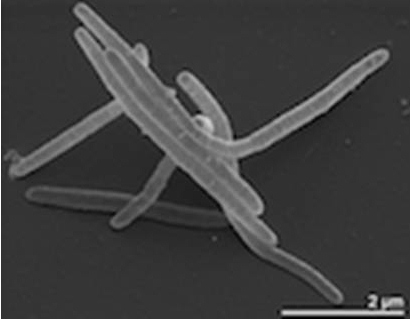Enterococcus Avium: Difference between revisions
| Line 18: | Line 18: | ||
==Description and significance== | ==Description and significance== | ||
Enterococcus <i>avium</i> is a rare infection in humans, but only a few reported cases are known. In such cases, E. avium may be vancomycin-resistant Enterococcus avium, and is referred to as VREA.VREA cases have been successfully treated with linezolid.E.avium is [http://en.wikipedia.org/wiki/Gram- | Enterococcus <i>avium</i> is a rare infection in humans, but only a few reported cases are known. In such cases, E. avium may be vancomycin-resistant Enterococcus avium, and is referred to as VREA.VREA cases have been successfully treated with linezolid.E.avium is [http://en.wikipedia.org/wiki/Gram-positive], non-pigmented, non-spore forming bacterium,usually in the shape of a sphere or oval, circular, and smooth colonies. | ||
==Genome structure== | ==Genome structure== | ||
Revision as of 02:04, 3 May 2012
A Microbial Biorealm page on the genus Enterococcus Avium
Classification
Higher order taxa

Domain: Bacteria
Phylum: Firmicutes
Class: Bacilli
Order: Lactobacillales
Family: Enterococcaceae
Genus: Enterococcus
Species
E. avium
Description and significance
Enterococcus avium is a rare infection in humans, but only a few reported cases are known. In such cases, E. avium may be vancomycin-resistant Enterococcus avium, and is referred to as VREA.VREA cases have been successfully treated with linezolid.E.avium is [2], non-pigmented, non-spore forming bacterium,usually in the shape of a sphere or oval, circular, and smooth colonies.
Genome structure
Marivirga tractousa chromosome is 4,511,574 base pairs long, and the chromosomes are circular. They have a 4916 sequence length, and they have 4516490 nucleotides. It has 3757 protein genes and 49 RNA genes. Its DNA coding region is at 4,029,412 base pair, and its DNA G+C content is 1,604,111 base pairs. Its total number of genes is 3,857. It has 2 rRNA operons, and 51 Psuedo genes.
Cell and colony structure
Marivirga tractuosa are long, slender, flexible rods 10-50 µm in length, 0.4-0.5 µm in width Colonies are circular, shiny and 2-4 mm in diameter after 72 hours of incubation on marine agar (which is a gelling agent from seaweed). They are usually dark-orange in color but whitish or yellow-pigmented are also sometimes present.
Metabolism
It is a strictly aerobic chemoorganotroph, meaning it uses organic compounds as its energy and carbon source. Carbon sources come from glycerol, glucose, galactose, and sucrose. Growth is observed at 10-40ºC and with 0.5–10% NaCl, with optimal growth at 28-32ºC and 4-7% NaCl.
Ecology
Marvirga tractuosa lives in a habitat that are mostly wet terrestrial habitats. They are also occasionally found in fresh water. Originally found on the beach sand from Nha Trang, Veitnam. Other strains have also been found in a variety of places: mud in the Orne Estuary, France and silty sand in Penang, Malaysia, as well as from brown mud from Muigh Inis, Ireland, underneath frozen sand in the upper littoral zone at Auke Bay, Alaska, red-brown mud from Helgoland Island, Germany, and from brown sand at Moreton Bay, Australia.
Pathology
It is not reported to be pathogenic.
References
[[3]Pagani, I.; Chertkov, O., Lapidus, A., Lucas, S., Glavina Del Rio, T., Tice, H., Copeland, A., Cheng, J., Nolan, M., Saunders, E., Pitluck, S., Held, B., Goodwin, L., Liolios, K., Ovchinnikova, G., Ivanova, N., Mavromatis, K., Pati, A., Chen, A., Palaniappan, K., Land, M., Hauser, L., Jeffries, C., Detter, J., Han, C., Tapia, R., Ngatchou, O., Rohde, M., Göker, M., Spring, S., Sikorski, J., Woyke, T., Bristow, J., Eisen, J., Markowitz, V., Hugenholtz, P., Klenk, H., & Kyrpides, N. (2011). Complete genome sequence of Marivirga tractuosa type strain (H-43T). Standards In Genomic Sciences, 4(2). doi:10.4056/sigs.1623941]
[[4]Yoon, Jaewoo, Naoya Oku, Sanghwa Park, Atsuko Katsuta, and Hiroaki Kasai. (2011) "Tunicatimonas Pelagia Gen. Nov., Sp. Nov., a Novel Representative of the Family Flammeovirgaceae Isolated from a Sea Anemone by the Differential Growth Screening Method." Antonie Van Leeuwenhoek 101.1: 133+, doi: 10.1007/s10482-011-9626-6]
[[5]Nedashkovskaya, O. I., M. Vancanneyt, S. B. Kim, and K. S. Bae. "Reclassification of Flexibacter Tractuosus (Lewin 1969) Leadbetter 1974 and 'Microscilla Sericea' Lewin 1969 in the Genus Marivirga Gen. Nov. as Marivirga Tractuosa Comb. Nov. and Marivirga Sericea Nom. Rev., Comb. Nov." International Journal Of Systematic And Evolutionary Microbiology 60.8 (2010): 1858-863. doi: 10.1099/ijs.0.016121-0]
Edited by Edited by Kayla Ferrara a student of Dr. Lisa R. Moore, University of Southern Maine, Department of Biological Sciences, [6]
